Anthony Bourdain finds himself in Berlin, Germany, a city that he came to perceive as a child, in simpliest terms, where East met West, and Good met Evil, and where he later came to discover every shade of gray was the result. It's a city, and a country, that has both repulsed and attracted. So now he's in Berlin to confront he's preconceptions. Besides, they promised him two of his most favorite things–pork and beer.
Introduction:
Berlin was successively the capital of the Kingdom of Prussia (1701–1918), the German Empire (1871–1918), the Weimar Republic (1919–1933) and the Third Reich (1933–1945). Berlin in the 1920s was the third largest municipality in the world. After World War II, the city was divided; East Berlin became the capital of East Germany while West Berlin became a de facto West German exclave, surrounded by the Berlin Wall (1961–1989).
The Berlin Wall was a 14 feet tall barrier constructed in 1961 by the German Democratic Republic (GDR, East Germany) that completely cut off West Berlin from East Berlin and surrounding East Germany. The barrier included guard towers placed along large concrete walls. The Wall served to prevent the massive emigration and defection from Germany and the communist Eastern Bloc during the Cold War.
The Revolutions of 1989 (also known as the Fall of Communism) lead to radical political changes in the Eastern Bloc, associated with Glasnot and the liberalization of the Eastern Bloc's authoritarian systems. After several weeks of civil unrest, the East German government announced on 9 November 1989 that all GDR citizens could visit West Germany and West Berlin. Over the next few weeks, a euphoric public and souvenir hunters chipped away parts of the wall; the governments later used industrial equipment to remove most of the rest. The fall of the Berlin Wall paved the way for German reunification, which was formally concluded on 3 October 1990. Following German reunification in 1990, the city regained its status as the capital of all Germany.
Economy:
In 2009, the nominal GDP of the citystate Berlin experienced a growth rate of 1.7% (−3.5% in Germany) and totaled €90.1 (~$117) billion. Berlin's economy is dominated by the service sector, with around 80% of all companies doing business in services. The unemployment rate reached a 15-year low in September 2011 and stood at 12.7% (German average: 6.6%).
Fast-growing economic sectors in Berlin include communications, life sciences, and transportation, particularly services that use information and communication technologies, as well as media and music, advertising and design, biotechnology, environmental services, and medical engineering.
Demographics:
As of March 2010, the city-state of Berlin has a population of has a population of 3.4 million people, and is Germany's largest city. It is the second most populous city proper and the eighth most populous urban area in the EU. About 25%-30% of the population is of foreign origin: 457,806 residents (13.5% of the population) were of foreign nationality, originating from 190 different countries. The largest groups of foreign nationals are those from Turkey (104,556), Poland (40,988), Serbia (19,230), Italy (15,842), Russia (15,332), France (13,262), Vietnam (13,199), the United States (12,733), Bosnia and Herzegovina (10,198), the United Kingdom (10,191), Croatia (10,104), and Israel (10,000); 394,000 citizens (12.2%) are descendants of international migrants and have either become naturalized German citizens or obtained citizenship by virtue of birth in Germany.
Culture:
Berlin is influenced by a temperate seasonal climate. Around one third of the city's territory is composed of forests, parks, gardens, rivers and lakes.
Berlin is a world city of culture, politics, media, and science, and is one of the most visited tourist destinations in the European Union (EU). The city is recognized for its festivals, diverse architecture, nightlife, contemporary arts, public transportation networks and a high quality of living.
Berlin has evolved into a global focal point for young individuals and artists attracted by a liberal lifestyle and modern zeitgeist. Berlin has a yearly total of approximately 135 million daily visitors, which puts it in third place among the most-visited city destinations in the European Union.
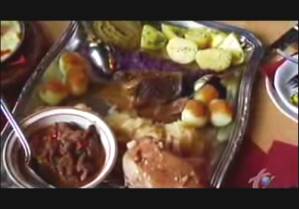 Berlin is home to a diverse gastronomy scene reflecting the immigrant history of the city. Twelve restaurants in Berlin have been included into the Michelin guide, which ranks the city at the top for the number of its restaurants having this distinction in Germany. Many local foods originated from north-German culinary traditions and include rustic and hearty dishes with pork, goose, fish, peas, beans, cucumbers or potatoes. Typical Berliner fares include Currywurst, Eisbein, the Berliner known as a Pfannkuchen, and Leber Berliner Art (Berlin-style liver). Turkish and Arab immigrant workers brought their culinary traditions to the city; for example, the döner kebab, falafel and lahmacun, which have become common fast-food staples.
Berlin is home to a diverse gastronomy scene reflecting the immigrant history of the city. Twelve restaurants in Berlin have been included into the Michelin guide, which ranks the city at the top for the number of its restaurants having this distinction in Germany. Many local foods originated from north-German culinary traditions and include rustic and hearty dishes with pork, goose, fish, peas, beans, cucumbers or potatoes. Typical Berliner fares include Currywurst, Eisbein, the Berliner known as a Pfannkuchen, and Leber Berliner Art (Berlin-style liver). Turkish and Arab immigrant workers brought their culinary traditions to the city; for example, the döner kebab, falafel and lahmacun, which have become common fast-food staples.
Episode Recap:
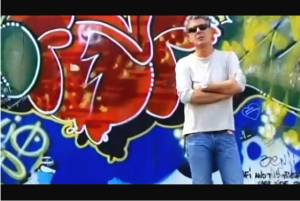 Anthony Bourdain starts his journey with a visit to remnants of the Berlin Wall. All the differences between the countries made the Berlin Wall a perfect place for people to express their opinions, especially on their preferences and dislikes. Graffiting on the wall became popular for artists from all over the world and a place where tourists would go and admire the artwork. The West Berlin side of the wall had artwork completely covering the wall, while the East Berlin side was kept blank. The Berlin wall was the largest canvas in the world; much of the artwork was not claimed by artists and remains anonymous. The Wall also spurred the development of a vibrant underground counterculture with some of the most provocative art and music.
Anthony Bourdain starts his journey with a visit to remnants of the Berlin Wall. All the differences between the countries made the Berlin Wall a perfect place for people to express their opinions, especially on their preferences and dislikes. Graffiting on the wall became popular for artists from all over the world and a place where tourists would go and admire the artwork. The West Berlin side of the wall had artwork completely covering the wall, while the East Berlin side was kept blank. The Berlin wall was the largest canvas in the world; much of the artwork was not claimed by artists and remains anonymous. The Wall also spurred the development of a vibrant underground counterculture with some of the most provocative art and music.
Propeller Island City Lodge: The Propeller Island City Lodge bills itself as a museum to stay overnight in. But after touring all 30 art-themed rooms, Anthony begins to second guest his choice and doubt whether he'll ever understand the German way of thinking.
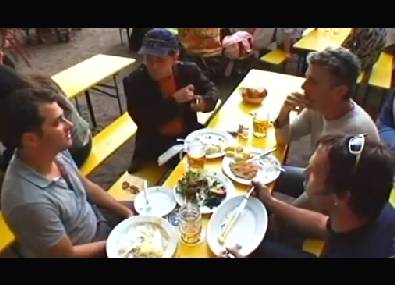 Prader Garden: Anthony joins his Berlin guide Stefan and some of Stefan's friends at Prader Garden, the oldest beer garden in Berlin. They order veal schnitzel (breaded veal cutlet) and beer, as well as hard-boiled eggs, meatballs, seasonal white asparagus, and a German version of French toast.
Prader Garden: Anthony joins his Berlin guide Stefan and some of Stefan's friends at Prader Garden, the oldest beer garden in Berlin. They order veal schnitzel (breaded veal cutlet) and beer, as well as hard-boiled eggs, meatballs, seasonal white asparagus, and a German version of French toast.
Soviet War Memorial: Intrigued with Berlin's Cold War period, Anthony meets up with Nigel Dunkly, a retired British Intelligence Officer (aka "spy") and an expert on the subject, as well as on Currywurst, a popular Berlin fast-food dish consisting of hot pork sausage cut into slices and seasoned with curry ketchup. They some currywurst, french fries, and a beer, before a visit to the Soviet War Memorial, a vast war memorial and military cemetery in Berlin's Treptower Park to commemorate 5,000 of the 80,000 Soviet soldiers who fell in the Battle of Berlin in April-May 1945.
Rogacki Gourmet Shop/Deli: Anthony stops by Rogacki Gourmet Shop/Deli and its miles of variety gourmet foods. He and his friend Natascha enjoy a meal of head cheese, various meats, fish, potatoes, salads, white asparagus and beer.
Jonathan Messe Art Studio: Anthony visits the artist in his studio. As internationally renowned avant-garde artist, Jonathan Messe is both political and controversial, and seriously committed to art as a tool to revolutionary change. They discuss the art scene and the madness of Messe's work.
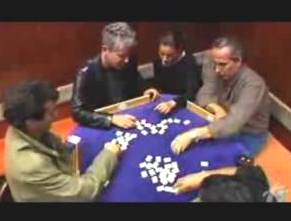 Kreuzberg: Anthony heads to Kreuzberg, one of Berlin's Turkish community, to meetup with Stefan's wife, Yanki, who is a Turk. The Turks in Berlin form the largest ethnic minority group with a population of around 250,000 to 300,000, making it the largest Turkish settlement outside of Turkey. The Turkish guest workers were largely responsible in part for the rapid reconstruction and economic development in German following World War II known as the German Miracle.
Kreuzberg: Anthony heads to Kreuzberg, one of Berlin's Turkish community, to meetup with Stefan's wife, Yanki, who is a Turk. The Turks in Berlin form the largest ethnic minority group with a population of around 250,000 to 300,000, making it the largest Turkish settlement outside of Turkey. The Turkish guest workers were largely responsible in part for the rapid reconstruction and economic development in German following World War II known as the German Miracle.
Zum Tor: Yanki takes Anthony to Zum Tor, a Turkish men's club where men drink coffee and play boardgames. Anthony joins a few of the regulars in a game of okey, a tile-based game.
Hasir Restaurant: Yanki takes Anthony to Hasir Restaurant for some Turkish cuisine, including various kabobs.
Trabant: Anthony takes a test drive around town in a Trabant, an automobile that was produced by a former East German auto maker. This car was once the most common vehicle in East Germany, and was also exported to countries both inside and outside the communist bloc. Today it is regarded with derisive affection as a symbol of the failed former East Germany and of the fall of communism in former West Germany, as many East Germans streamed into West Berlin and West Germany in their Trabants after the opening of the Berlin Wall in 1989.
Bräustübl: Anthony and Nigel enjoy a traditional German meal at Bräustübl in old East Berlin with Gregor Gysi, a German attorney and key politician of the socialist political party The Left (Die Linke). He played an important role in the end of communist rule in East Germany in 1989, and was a main figure in the post-reunification Party of Democratic Socialism (PDS). Bräustübl oozes 1920s Berlin charisma from every nook and cranny. Their menu features hearty, old-timey German classics rich in fats such as pig shank, gulash, potatoes, sauerkraut, German mustard.
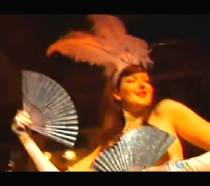 Chamaeleon Theatre: Anthony meets up with burlesque performer Dana to see one of the best cabaret shows in Berlin, Soap, at the historic Chamaeleon Theatre. The show combines acrobatics and bathtubs. Afterwards, Anthony has some drinks with the performers while Dana does her burlesque bump and grind for the audience.
Chamaeleon Theatre: Anthony meets up with burlesque performer Dana to see one of the best cabaret shows in Berlin, Soap, at the historic Chamaeleon Theatre. The show combines acrobatics and bathtubs. Afterwards, Anthony has some drinks with the performers while Dana does her burlesque bump and grind for the audience.
Anthony concludes that Berlin was an unexpected pleasure. The food was good, but more importantly, so was the city itself and its people who are an intriguing mix of brash and outspoken on the one hand, guarded and somewhat enigmatic on the other. Some cities put on a good face and seem to go out of their way to try to please you. Berliners are willing to size you up and give you what they think you can handle. Anthony was left with the impression that he was only getting a part of each story and that whole worlds, alternate histories existed just beneath the surface, close but always just out of reach to him.
Episodes:
 |
ARGENTINA: From the Tango to paragliding to cattle rustling to trekking along icy glaciers, Anthony experiences it all. |
 |
AUSTRALIA: Melbourne has been described as San Francisco without the fog. Anthony is off to discover what makes it so special. |
 |
BRAZIL: Some say São Paulo feels like LA threw up on NYC. But Anthony's back for the great food and its welcoming people. |
 |
CALCUTTA & BOMBAY: Anthony revisits his love for India's vibrant culture, cuisine & communities with a trip to Kolkata & Mumbai. |
 |
COLOMBIA: A bright and beautiful country that has gone from drug capital to food capital. Anthony explores its unique cuisine. |
 |
EGYPT: Anthony skips the long lines and tour buses, and visits with Egyptian locals to get a taste for what it means to be Egyptian. |
 |
GHANA: Anthony heads to Ghana, West Africa, a land of old forts and slave castles, and a culture filled with great food and music. |
 |
GREEK ISLES: Anthony is on a culinary odyssey to discover if Greece really does have the world's healthiest diet. |
 |
HONG KONG: A wonder-land of colors, lights and speed, a perfect marriage of modern and traditional, and home to great Asian cuisine. |
 |
IRELAND: Ireland's steeped in history and traditions, both oral & written. Anthony dispels the myths that it has the worst food on the planet. |
 |
JAMAICA: Jamaica is a vibrant, colorful land full of resorts and reggae music. Anthony is there to uncover the lesser-known Jamaica. |
 |
KOREA: Anthony gives in to his employee's pressure to visit Korea and, next thing you know, they're in Seoul and the adventure begins. |
 |
MEXICO: Carlos, a head chef in NYC and good friend, gives Anthony a culinary tour of his hometown Puebla and nearby Mexico City. |
 |
OSAKA (Japan): Anthony learns all about kuidaore, which means to bankrupt oneself with extravagance in food and drink! |
 |
PARIS: In this very first episode of the series, Anthony heads to the "City of Light" to show, at least the Americans, why the French don't suck. |
 |
PERU: Anthony is on a mission to obtain personal enlightenment in a land of ancient culture, rich cuisine, and vibrant people. |
 |
QUEBEC (Canada): Anthony is off to Québec to indulge in one of his most hedonistic pleasures–foie gras (fatty duck liver). |
 |
RAJASTHAN (India): From gorgeous sights to enticing smells, Anthony explores the magical and delicious offerings of Rajasthan. |
 |
ROME: Anthony adopts the mindset of the Roman people–living a simple life and eating fresh, seasonal ingredients. |
 |
RUSSIA: Anthony explores Russia, where the food is hearty. Along the way he meets a former Cold War spy and Miss Russia. |
 |
SHANGHAI (China): Anthony is back in China. From Shanghai to Tibet, he searches for the mythical Shangri-La. |
 |
SICILY: Anthony starts his gastronomic tour through Sicily in style by sharing a spleen sandwich with Sicily's president. |
 |
SINGAPORE: Singapore is serious about food and offers up a cuisine like no other. Anthony dives in head-first. |
 |
SPAIN: According to Anthony, outside of Asia, Spain is the single greatest place for culinary achievement in the world. |
 |
TOKYO: Anthony is off to Tokyo in search of the relationship between a perfect piece of sushi and a perfect knife blade. |
 |
TUSCANY: Anthony travels to the beautiful Tuscan countryside to visit with friends and enjoy some homemade pasta that's out of this world. |
 |
URUGUAY: Anthony and his brother are on a mission to connect with their roots in Uruguay after learning that Bourdains once settled here. |
 |
VANCOUVER (Canada): Anthony visits Vancouver, home to a thriving film industry, gorgeous scenery, and an evolving food scene. |
Contact Us | Shop | Sitemap | Join Our Team | Investors | Advertise | Web Design Services
Community | Foodies' Choice | Meetup Groups | Chat | Blogs | Forums | Submit Your Site | Resources

